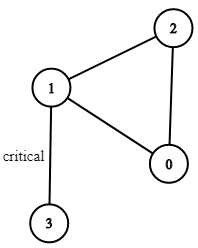There are n servers numbered from 0 to n-1 connected by undirected server-to-server connections forming a network where connections[i] = [a, b] represents a connection between servers a and b. Any server can reach any other server directly or indirectly through the network.
A critical connection is a connection that, if removed, will make some server unable to reach some other server.
Return all critical connections in the network in any order.
Example 1:

Input: n = 4, connections = [[0,1],[1,2],[2,0],[1,3]]
Output: [[1,3]]
Explanation: [[3,1]] is also accepted.
Constraints:
1 <= n <= 10^5n-1 <= connections.length <= 10^5connections[i][0] != connections[i][1]- There are no repeated connections.
Solution:
Tarjan’s algo for finding articulation points
class Solution {
public:
void art(int u, int& cnt, vector<int>& dfs, vector<int>& low, vector<int>& par, vector<vector<int>>& edge, vector<vector<int>>& ans){
dfs[u] = cnt++;
low[u] = dfs[u];
cout<<u<<" "<<dfs[u];
for(int v : edge[u]){
if(dfs[v] == -1){
par[v] = u;
art(v, cnt, dfs, low ,par, edge, ans);
low[u] = min(low[u], low[v]);
if(low[v] > dfs[u]){
ans.push_back(vector<int>{u,v});
}
}else if(v != par[u]){
low[u] = min(low[u], dfs[v]);
}
}
}
vector<vector<int>> criticalConnections(int n, vector<vector<int>>& conn) {
vector<int> dfs(n,-1);
vector<int> low(n,-1);
vector<int> par(n,-1);
int cnt = 0;
vector<vector<int>> ans;
vector<vector<int>> edge(n);
for(int i = 0;i < conn.size(); i++){
int x = conn[i][0];
int y = conn[i][1];
edge[x].push_back(y);
edge[y].push_back(x);
}
art(0, cnt, dfs, low ,par, edge, ans);
return ans;
}
};
